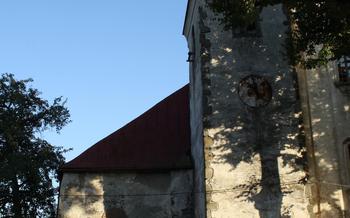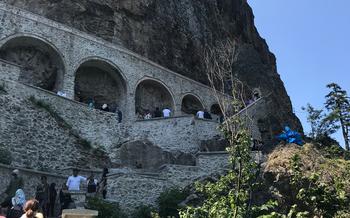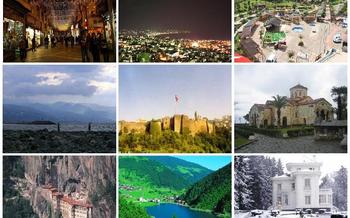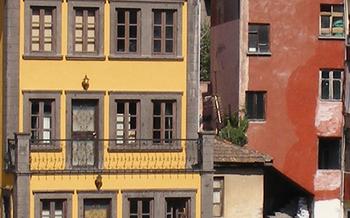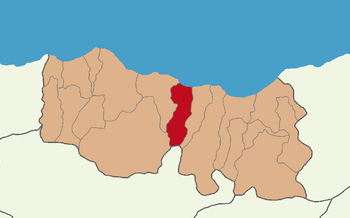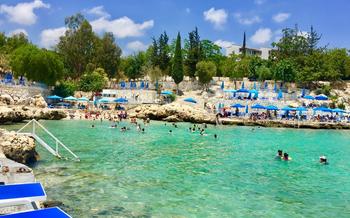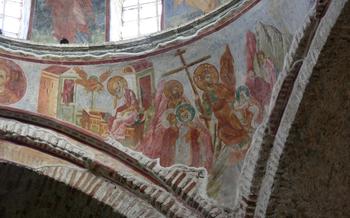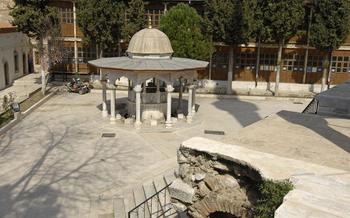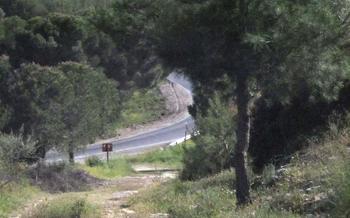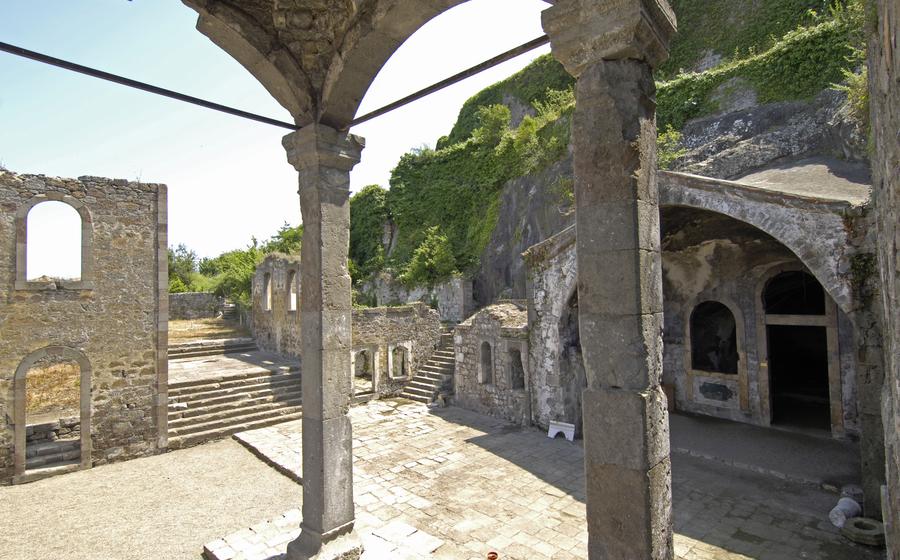
Kızlar Monastery
- Historical Significance
- Location and Access
- Architectural Marvel
- Paintings and Mosaics
- The Legend of the Forty Girls
- Breathtaking Views
- Monastic Life
- Pilgrimage Site
- Restoration Efforts
- UNESCO World Heritage Site
- Local Cuisine
- Souvenirs and Handicrafts
- Nearby Attractions
- Accommodation Options
- Insider Tip:
Historical Significance
The Kızlar Monastery, also known as the Monastery of the Forty Virgins, holds a significant position in the history of the Eastern Orthodox Church. Founded in the 14th century by the Byzantine Emperor Alexios III, this monastery served as a spiritual and cultural center for the local Orthodox Christian community. Over the centuries, it became a prominent pilgrimage site, attracting devout believers from far and wide. However, due to political shifts and the changing religious landscape, the monastery eventually fell into disuse and was abandoned. Today, its ruins stand as a testament to its former glory and invite visitors to explore its rich heritage.
Location and Access
The Kızlar Monastery is situated in the scenic Çaykara district, approximately 50 kilometers southwest of Trabzon. Nestled amidst the lush green mountains and tranquil valleys, the monastery offers a serene retreat from the city's hustle and bustle.
To reach the monastery, visitors can take a scenic drive along the winding roads that lead through picturesque villages and breathtaking landscapes. The journey takes about an hour and a half, providing ample opportunities to admire the region's natural beauty.
Alternatively, visitors can opt for public transportation, which is a convenient and affordable option. Regular buses depart from Trabzon's main bus station and take passengers directly to Çaykara. From there, a short taxi ride or a leisurely walk will take you to the monastery's gates.
Guided tours are also available for those who prefer a more immersive and informative experience. These tours typically include transportation from Trabzon, a knowledgeable guide who can provide insights into the monastery's history and architecture, and ample time to explore the grounds at your own pace.
Architectural Marvel
The Kızlar Monastery stands as a testament to the architectural prowess of its builders. Constructed using local stone and mortar, the monastery seamlessly blends into the surrounding landscape. Its exterior walls, adorned with intricate carvings and decorative elements, hint at the beauty that lies within. Step inside, and you'll be greeted by a series of interconnected chambers, each serving a specific purpose. The main church, the heart of the monastery, boasts a grand dome that filters in soft light, illuminating the vibrant frescoes and mosaics that adorn its walls. The cells, where the monks once resided, are simple and austere, reflecting their humble lifestyle. The refectory, where they gathered for meals, features a long central table and benches, creating a sense of communal dining. Every corner of the Kızlar Monastery reveals a unique architectural detail, showcasing the skill and devotion of its creators.
Paintings and Mosaics
The Kızlar Monastery is renowned for its exquisite collection of paintings and mosaics, which are considered to be among the finest examples of Byzantine art in the region. These stunning works of art adorn the walls and ceilings of the monastery's interior, creating a visually captivating and awe-inspiring atmosphere.
The paintings and mosaics depict a variety of religious scenes and figures, including Jesus Christ, the Virgin Mary, and various saints. They are rendered in rich colors and intricate detail, showcasing the skill and artistry of the Byzantine masters who created them.
One of the most notable paintings is the depiction of the Last Supper, which is located in the apse of the church. The painting portrays Jesus and his disciples gathered around a table, sharing their final meal together before his crucifixion. The expressions on the faces of the figures and the vibrant colors used to create the scene convey a sense of emotion and drama that is both captivating and moving.
Another highlight of the monastery's art collection is the mosaic of the Virgin Mary and Child, which is located in the narthex. The mosaic depicts the Virgin Mary holding the infant Jesus in her arms, surrounded by a halo of light. The intricate tesserae used to create the mosaic create a shimmering effect that adds to the beauty and majesty of the artwork.
These paintings and mosaics are not only masterpieces of art but also hold immense religious and historical significance. They provide a glimpse into the beliefs and practices of the Eastern Orthodox Church during the Byzantine period and serve as a reminder of the rich cultural heritage of the region.
The Legend of the Forty Girls
The name "Kızlar Monastery" is steeped in a poignant legend that has captured the imagination of generations. According to local folklore, the monastery was once home to forty young women who sought refuge within its walls to escape forced marriages or other misfortunes. These women, known as "kızlar" or "girls" in Turkish, found solace and protection within the monastery's sacred grounds. Over time, the monastery became a symbol of hope and sanctuary for women seeking refuge from various adversities.
The legend of the forty girls has become an integral part of the Kızlar Monastery's identity. It serves as a reminder of the resilience and strength of women throughout history. Visitors to the monastery can still feel the presence of these young women as they explore the ancient ruins, each stone whispering tales of their struggles, sacrifices, and unwavering faith.
Breathtaking Views
The Kızlar Monastery is not only a religious and historical site but also a place of unparalleled beauty. Perched atop a hill, the monastery offers breathtaking panoramic vistas that will leave you in awe. The elevated position of the monastery allows visitors to gaze upon a mesmerizing landscape that stretches as far as the eye can see. The lush green forests that surround the monastery create a picturesque backdrop, while the distant peaks of the Pontic Mountains add a touch of grandeur to the scene. On a clear day, visitors can even catch a glimpse of the sparkling Black Sea, shimmering in the sunlight. The Kızlar Monastery is a true haven for nature lovers and photography enthusiasts, providing ample opportunities to capture stunning images that will serve as lasting reminders of your visit.
Monastic Life
The Kızlar Monastery was once home to a thriving community of monks who dedicated their lives to religious devotion and contemplation. These monks followed a strict monastic code, adhering to daily routines of prayer, fasting, and manual labor. They spent their days in the monastery's church, tending to its upkeep and performing religious ceremonies. The cells, or small living quarters, provided them with basic necessities, while the refectory served as a communal dining hall.
Monks at the Kızlar Monastery played a significant role in preserving and spreading Christianity in the region. They were known for their scholarship and their contributions to religious literature. Through their teachings and interactions with the local population, they helped to strengthen the faith and promote spiritual growth.
Although the monastery is no longer inhabited by monks, visitors can still sense the presence of their spiritual legacy. The monastery's well-preserved architecture, artifacts, and inscriptions offer a glimpse into the lives of these devoted individuals. By exploring the monastery's sacred spaces, visitors can gain a deeper understanding of the monastic traditions that once flourished within its walls.
Pilgrimage Site
The Kızlar Monastery holds significant religious importance as a pilgrimage site for Christians from around the world. The monastery's sacred atmosphere and historical significance attract pilgrims who seek spiritual experiences and a deeper connection to their faith. Pilgrims visit the monastery to pay homage to its patron saints, offer prayers, and seek blessings. They participate in special ceremonies, light candles, and engage in contemplative practices within the monastery's hallowed halls. The monastery's serene environment provides a sanctuary for pilgrims to reflect on their spiritual journeys and find solace and tranquility. During pilgrimage seasons, the monastery welcomes a steady stream of devout visitors who come to immerse themselves in its spiritual aura and seek divine guidance and inspiration.
Restoration Efforts
The Kızlar Monastery has undergone extensive restoration efforts in recent years, aiming to preserve and protect its cultural and historical heritage. These efforts are crucial in ensuring that the monastery remains a testament to the region's rich past and continues to serve as a valuable cultural resource.
The restoration process involves meticulous attention to detail, using traditional techniques and materials to maintain the monastery's authenticity. Skilled craftsmen and conservators work diligently to repair damaged structures, restore intricate frescoes, and reinforce the monastery's foundations. The goal is to preserve the monastery's unique architectural features and ensure its structural stability for future generations.
Challenges during the restoration process include sourcing authentic materials, addressing the effects of natural wear and tear, and ensuring that the work is carried out in a manner that respects the monastery's historical integrity. Despite these challenges, the restoration efforts have made significant progress, bringing new life to the Kızlar Monastery and allowing visitors to appreciate its grandeur once again.
UNESCO World Heritage Site
The Kızlar Monastery holds a prestigious designation as a UNESCO World Heritage Site, a testament to its exceptional cultural and historical significance. This recognition was bestowed upon the monastery in 2013, joining the ranks of other remarkable landmarks around the globe. To be included on this prestigious list, a site must meet at least one of ten selection criteria established by UNESCO.
In the case of the Kızlar Monastery, it satisfied criterion (iv), which recognizes structures that are outstanding examples of a particular architectural or technological type, or that illustrate an important stage in human history. The monastery's unique architectural features, including its distinctive vaulted ceilings, intricate carvings, and well-preserved frescoes, played a crucial role in its inclusion on the World Heritage List.
With this designation comes a sense of responsibility to preserve and protect the monastery's heritage for future generations. The Turkish government and local authorities have undertaken extensive restoration and conservation efforts to ensure the monastery's continued existence. Visitors to the Kızlar Monastery can appreciate the fruits of these efforts, as the site continues to stand as a testament to the rich cultural and religious history of the region.
Local Cuisine
While visiting Trabzon, take the opportunity to indulge in the region's delectable cuisine. The city boasts a vibrant culinary scene, influenced by its diverse cultural heritage. To savor authentic Turkish flavors, venture into the local restaurants and eateries. Try the mouthwatering "hamsi," a local delicacy consisting of freshly caught anchovies fried to perfection. Don't miss the chance to taste "kelle paça," a traditional soup made from sheep's head and trotters, known for its rich and savory broth. For a sweet treat, try the famous "künefe," a shredded pastry filled with melted cheese and drizzled with sweet syrup. Whether you prefer dining in a cozy restaurant or grabbing a quick bite from a street vendor, Trabzon's culinary delights will surely tantalize your taste buds and leave you craving for more.
Souvenirs and Handicrafts
The vibrant city of Trabzon offers a treasure trove of unique souvenirs and handicrafts for visitors to cherish. From traditional Turkish carpets and kilims to intricate silver jewelry and hand-painted ceramics, there's something for every taste and budget. One can find an array of these treasures at local bazaars, specialty shops, and artisan workshops scattered throughout the city.
For those seeking authentic souvenirs, the Uzun Sokak market is a must-visit. This bustling bazaar is a haven for shoppers, offering an eclectic mix of textiles, spices, handicrafts, and local delicacies. Here, visitors can haggle for unique souvenirs while immersing themselves in the lively atmosphere of Turkish market culture.
Another popular shopping destination is the Arasta Bazaar, located in the heart of the city. This historic bazaar, with its charming cobblestone streets and arched doorways, houses a variety of shops selling traditional Turkish handicrafts, including hand-woven rugs, copperware, and leather goods.
For those interested in unique and contemporary souvenirs, the city's art galleries and boutiques offer a curated selection of modern Turkish art, jewelry, and home décor. These galleries showcase the works of local artists and designers, providing visitors with the opportunity to take home a piece of contemporary Turkish culture.
My personal recommendation for a unique souvenir is the Trabzon silver jewelry. Intricately handcrafted by local artisans, these pieces are renowned for their delicate designs and intricate filigree work. Whether it's a necklace, bracelet, or earrings, Trabzon silver jewelry is a timeless keepsake that captures the essence of Turkish craftsmanship.
Nearby Attractions
The Kızlar Monastery is surrounded by a wealth of other attractions that visitors can explore. Just a short distance away lies the breathtaking Sumela Monastery, perched on a cliff overlooking the Altındere Valley. Visitors can marvel at its stunning architecture, intricate frescoes, and the panoramic views it offers.
Another must-visit destination is the Uzungöl Nature Park, located approximately 60 kilometers from the Kızlar Monastery. This picturesque lake, surrounded by lush forests and towering mountains, provides a tranquil escape from the city. Visitors can enjoy leisurely walks, boat rides, and trout fishing, making it an ideal spot for nature enthusiasts.
For those interested in history and culture, the Trabzon Museum is a treasure trove of artifacts and exhibits showcasing the region's rich past. Visitors can learn about the diverse civilizations that have shaped Trabzon, from the ancient Greeks and Romans to the Byzantine and Ottoman empires.
To make the most of your time in the area, consider creating an itinerary that allows you to visit multiple attractions. Plan to spend a full day exploring the Kızlar Monastery and its surroundings, including the Sumela Monastery and the Uzungöl Nature Park. Dedicate another day to visit the Trabzon Museum and other nearby attractions, such as the Boztepe Hill and the Atatürk Pavilion. This will ensure you have ample time to immerse yourself in the region's cultural and natural wonders.
Accommodation Options
When planning your trip to the Kızlar Monastery, finding suitable accommodation is crucial. Fortunately, there are various options available near the monastery, catering to different preferences and budgets.
For those seeking a comfortable and convenient stay, several hotels are located within a short distance from the monastery. These hotels offer modern amenities, including spacious rooms, private bathrooms, and often stunning views of the surrounding landscape.
If you prefer a more immersive experience, consider staying at a local guesthouse or homestay. These accommodations provide an opportunity to interact with friendly locals and gain insights into their culture and way of life. Guesthouses typically offer cozy rooms and home-cooked meals, allowing you to savor the authentic flavors of Turkish cuisine.
For budget-conscious travelers, hostels are an excellent option. These shared accommodations provide a social atmosphere and a chance to meet fellow travelers from around the world. Hostels often have basic facilities but offer a comfortable and affordable place to rest your head after a day of exploring.
To ensure a hassle-free stay, it's advisable to book your accommodation in advance, especially during the peak tourist season. This will guarantee your desired room type and avoid any last-minute surprises. Online booking platforms and local travel agencies can assist you in finding the perfect accommodation that suits your needs and preferences.
Insider Tip:
For an unforgettable experience, time your visit to the Kızlar Monastery during the annual religious festivals held in the region. Immerse yourself in the vibrant atmosphere as locals and pilgrims gather to celebrate their faith. Participate in traditional ceremonies, witness colorful processions, and savor the delicious local cuisine prepared for these special occasions. It's a unique opportunity to connect with the spiritual and cultural heritage of the monastery and the surrounding community.
